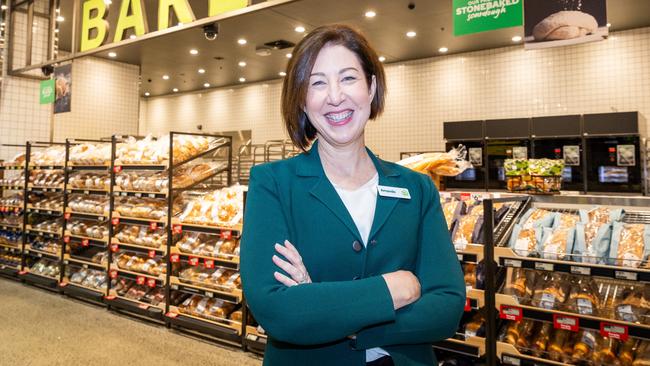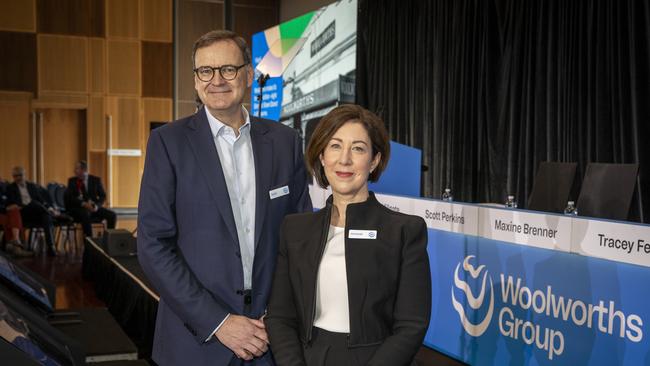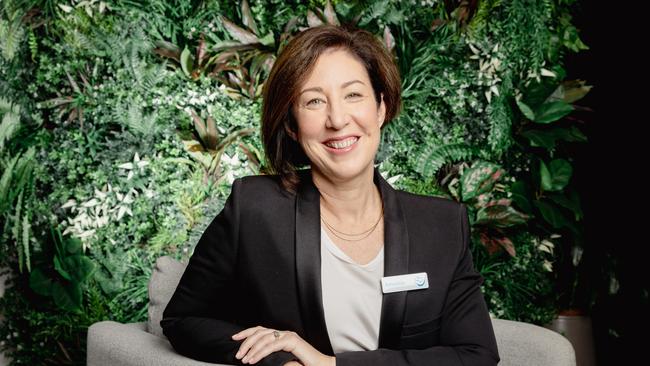Woolworths has missed analyst expectations with its interim earnings
Warehouse strikes, higher wages and falling customer satisfaction have hurt Woolworths’ profit with the retailer’s CEO conceding it needs to do better and will cut costs by $400m.

Woolworths boss Amanda Bardwell will take an axe to the sprawling retailer’s back-office operations and cut out $400m in costs as she reinvests some of those savings into lower prices to lure back dissatisfied shoppers, admitting it needs “to do better” after disappointing earnings.
After its interim results significantly undershot market forecasts on Thursday, Ms Bardwell confessed “we know we need to do better” and was backed by chairman Scott Perkins who intervened and conceded the performance in the half was “below our expectations.”
While she has pledged to bring simplification and efficiency to its flagship Australian supermarkets arm - which delivers 95 per cent of group earnings - as well as provide better value for shoppers, Ms Bardwell will also review its portfolio of businesses which could see it sell off its struggling Big W and New Zealand supermarkets arms.
But her key focus will be getting the Australian supermarket arm fighting fit amid what she dubbed a recent acceleration of consumer trends in terms of cross-shopping, value, trading down to cheaper groceries and cost-of-living pressures - and which Woolworths looks to have lost out on.
“We have more work to do … we know we need to do better. Customers are shopping with us, we would just like them to put more items in the basket,” Ms Bardwell said as Woolworths unveiled a December half net profit of $741m, against a loss of $781m for the previous corresponding period. Lower earnings at its Australian supermarkets tarnished the result and it missed analyst expectations, with the market pencilling in profit of $783.8m.
Sales at its Australian supermarkets were up only 2.7 per cent to $26.66bn with earnings for the crucial division falling 12.8 per cent to $1.39bn. Overall Woolworths earnings were weaker by 14.2 per cent to $1.45bn and the dividend was cut by 17 per cent to 39c per share, payable on April 23.
The $95m in costs related to protracted industrial action at some of its warehouses in the lead up to Christmas. This hurt earnings and customer satisfaction - with some sales in Victoria still not fully returning - but on the Woolworths board there was the stark admission the retailer needed to do better and this would be Ms Bardwell’s focus.

“The performance in the half was below our expectations with a combination of rapidly changing customer behaviours and significant disruption,” admitted Woolworths chairman Mr Perkins. “We are focused on addressing these challenges and under our new CEO ... we have a clear set of priorities for 2025.”
Her key strategy, unveiled on Wednesday, will be $400m in savings generated by cuts to its support office which will include unspecified job losses and achieved by the end of calendar 2025. This will partly offset rising costs within the business, such as wages, and also deliver a more simplified structure as Woolworths ups its game amid a fast-changing consumer environment.
“I think what we’ve seen from customers is certainly a call out from a sentiment perspective, for some time that customers are seeking value. What we saw last year was a quite significant acceleration of a change in behavior,” Ms Bardwell told The Australian.
“And so we shifted from customers calling out that they were looking for value to actually actively seeing that behavior in our stores, in terms of seeking more specials, looking to find more ‘own brands’ (private label), checking and comparing prices, and in fact, in many instances now cross shopping as well.
“It’s always important that we are absolutely understanding where a customer’s behavior is up to and what it is that our customers want. And we’ve been very focused on making sure that customers get great value at Woolworths. Certainly, we’ve increased the level of investment that we’ve been putting into our price and promotions and we have increased the visibility of our promotions in our store as well.”
Ms Bardwell wouldn’t detail where the $400m in targeted savings would flow, to lower shelf prices or more profit for shareholders, but signalled lower prices were a priority.
“At the right time we will make a decision as to where the funds should be best invested. It’s always going to be our priority to make sure that customers are getting great value at Woolworths first and foremost.”

Bank of America analyst David Errington was more circumspect about Woolworths’s ability to repair its profit and questioned if the retailer couldn’t ratchet up profitability at its supermarket arm the market would question its investability.
“EBIT is down, going backwards, I do understand the challenging conditions, but a company of the quality of Woolworths we just can’t see the company going backwards on a like-for-like basis … so other than pulling out costs at head office, what are you going to do to improve the underlying performance?
“Unless you can grow underlying profits on your best business (supermarkets) … then it’s not investable.”
Meanwhile, the retailer said in Australia its supermarket sales growth of 3.3 per cent in the first seven weeks of the second half was driven by a more stable trading environment following the recovery from industrial action, cycling lower growth in the prior year, a collectibles program and ongoing e-commerce growth.
Shares in Woolworths ended down 96c at $30.60.






To join the conversation, please log in. Don't have an account? Register
Join the conversation, you are commenting as Logout